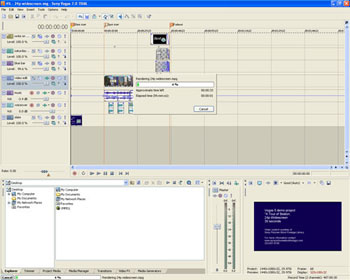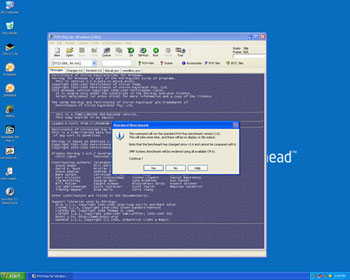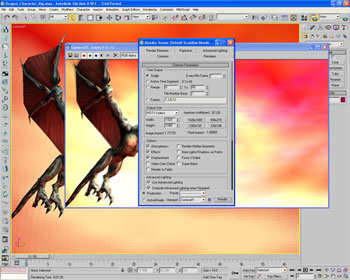Quad Cores: Intel Kentsfield Preview
by Anand Lal Shimpi on September 28, 2006 7:00 PM EST- Posted in
- CPUs
Kentfield Performance
Updated: We initially had a flawed equation for determining percentage differences on the time-based benchmarks. When higher scores are better, it is easy to state that something is a certain percentage faster. For timed tasks, the proper terminology would be how much longer the slow machine takes, or alternately what percentage of the time it would take the faster machine to complete the same task. The percentages now represent an advantage for POV-Ray, PCMark05, and 3DMark06 CPU, while in DivX, Sony Vegas and 3dsmax 8 the percentages are how much longer the X6800 takes. Hopefully, that will help make things clear (as mud).
The DivX performance test is similar to the encoding test we run for our usual CPU reviews, although Intel runs it with higher quality settings so that it stresses the CPU more. Here, the lower clocked, quad-core Core 2 Extreme QX6700 can encode the video in 72.6% of the time of the X6800, or put another way the X6800 takes 37.7% longer. Assuming linear frequency scaling, quad-cores could complete the video encoding in around 66% of the time as dual cores, or dual cores would take 51.4% longer in DivX encoding.
Sony's Vegas application is an Adobe Premier-like application, and rendering video in it is a highly multi-threaded workload. We see that the X6800 takes 50.9% longer than the QX6700. Were we to have equal clock speeds, dual core would take around 66% longer.
Using the POV-Ray multi-threaded beta we ran the application's built in benchmark and noticed a tremendous increase in performance. The QX6700 is over 80% faster than the X6800 thanks to a doubling in the number of cores. Estimating performance scaling at equal clock speeds again, we should get nearly twice the performance with four cores as with two cores, a 98% performance increase.
The 3dsmax 8 test is simply rendering a single frame at high resolution, and the X6800 takes 63.3% longer than the QX6700. Accounting for clock speed differences, dual cores should take about 80% longer than quad cores.
PCMark05's overall score gives you more of an idea of what you can expect for workloads that aren't highly multithreaded, where there's a reduction in performance thanks to the lower clock speed. Looking at the CPU test in specific, there's an advantage to the quad-core setup but it is under 15%, much lower than some of the other workloads. At identical speeds, quad cores should still be a bit faster than dual cores in PCMark05 (8% and 26% faster respectively). This is a far more typical usage scenario for your average user than highly threaded video and 3D rendering applications, unfortunately, and in gaming tests we expect QX6700 to often be slightly slower than X6800.
Rounding off the tests that were loaded on the system we've got 3DMark 06's CPU test, which is obviously multithreaded as is evident by the 57% increase in performance on the QX6700 processor. Were we to have a 2.93 GHz QX6800, the estimated performance would be 73% higher than dual core. Obviously most games today won't show anywhere near that sort of performance improvement due to quad-core, but if Remedy's Alan Wake is any indication of what's to come, quad-core gaming may be a reality starting as early as 2007.
Closing Thoughts
With only a 266MHz difference in clock speed, the new Core 2 Extreme QX6700 isn't too hard of a choice to make. When Intel introduces a lower cost 2.40GHz Core 2 Quad version, things may get a little more complicated, but at the very high end we would rather have four slightly slower cores than two slightly faster cores. We expect that there will be some improvements in multitasking performance, especially if you have a decently fast I/O setup, and don't forget the performance boost you'll get in well threaded applications.
The first quad-core CPUs will be available in November of this year, with more affordable offerings being introduced early next year. Building on top of the already excellent performance of Intel's Core 2 Duo processors, Intel's quad-core solutions will offer a very attractive upgrade path for those users that have invested in the right motherboards today. We're currently working on putting together a list of all currently shipping motherboards that will support Kentsfield to best help you plan for a more upgrade-friendly machine, and we will have the initial list available later today.
Updated: We initially had a flawed equation for determining percentage differences on the time-based benchmarks. When higher scores are better, it is easy to state that something is a certain percentage faster. For timed tasks, the proper terminology would be how much longer the slow machine takes, or alternately what percentage of the time it would take the faster machine to complete the same task. The percentages now represent an advantage for POV-Ray, PCMark05, and 3DMark06 CPU, while in DivX, Sony Vegas and 3dsmax 8 the percentages are how much longer the X6800 takes. Hopefully, that will help make things clear (as mud).
| DivX 6.2.5 w/ XMPEG 5.03 (encoding time in seconds) | |||
| Core 2 Extreme QX6700 (2.66GHz 2x4MB/Quad) |
Core 2 Extreme X6800 (2.93GHz 4MB/Dual) |
Percentage Disadvantage (X6800 vs. QX6700) |
Clock Scaling Estimate (Quad vs. Dual) |
| 77 | 106 | 37.7% | 51.4% |
The DivX performance test is similar to the encoding test we run for our usual CPU reviews, although Intel runs it with higher quality settings so that it stresses the CPU more. Here, the lower clocked, quad-core Core 2 Extreme QX6700 can encode the video in 72.6% of the time of the X6800, or put another way the X6800 takes 37.7% longer. Assuming linear frequency scaling, quad-cores could complete the video encoding in around 66% of the time as dual cores, or dual cores would take 51.4% longer in DivX encoding.
 |
| Click to enlarge |
| Sony Vegas 7.0a (rendering time in seconds) | |||
| Core 2 Extreme QX6700 (2.66GHz 2x4MB/Quad) |
Core 2 Extreme X6800 (2.93GHz 4MB/Dual) |
Percentage Disadvantage (X6800 vs. QX6700) |
Clock Scaling Estimate (Quad vs. Dual) |
| 252.9 | 381.6 | 50.9% | 66.0% |
Sony's Vegas application is an Adobe Premier-like application, and rendering video in it is a highly multi-threaded workload. We see that the X6800 takes 50.9% longer than the QX6700. Were we to have equal clock speeds, dual core would take around 66% longer.
 |
| Click to enlarge |
| POV-Ray Beta 15 (pixels per second) | |||
| Core 2 Extreme QX6700 (2.66GHz 2x4MB/Quad) |
Core 2 Extreme X6800 (2.93GHz 4MB/Dual) |
Percentage Advantage (QX6700 vs. X6800) |
Clock Scaling Estimate (Quad vs. Dual) |
| 2583 | 1431 | 80.5% | 98.55% |
Using the POV-Ray multi-threaded beta we ran the application's built in benchmark and noticed a tremendous increase in performance. The QX6700 is over 80% faster than the X6800 thanks to a doubling in the number of cores. Estimating performance scaling at equal clock speeds again, we should get nearly twice the performance with four cores as with two cores, a 98% performance increase.
 |
| Click to enlarge |
| 3dsmax 8 SP2 (rendering time in seconds) | |||
| Core 2 Extreme QX6700 (2.66GHz 2x4MB/Quad) |
Core 2 Extreme X6800 (2.93GHz 4MB/Dual) |
Percentage Disadvantage (X6800 vs. QX6700) |
Clock Scaling Estimate (Quad vs. Dual) |
| 49 | 80 | 63.3% | 79.6% |
The 3dsmax 8 test is simply rendering a single frame at high resolution, and the X6800 takes 63.3% longer than the QX6700. Accounting for clock speed differences, dual cores should take about 80% longer than quad cores.
| PCMark05 Professional | ||||
| . | Core 2 QX6700 (2.66GHz 2x4MB/Quad) |
Core 2 X6800 (2.93GHz 4MB/Dual) |
Percentage Advantage (QX6700 vs. X6800) |
Clock Scaling Estimate (Quad vs. Dual) |
| Overall | 7594 | 7706 | -1.5% | 8.40% |
| CPU Score | 8485 | 7406 | 14.6% | 26.03% |
PCMark05's overall score gives you more of an idea of what you can expect for workloads that aren't highly multithreaded, where there's a reduction in performance thanks to the lower clock speed. Looking at the CPU test in specific, there's an advantage to the quad-core setup but it is under 15%, much lower than some of the other workloads. At identical speeds, quad cores should still be a bit faster than dual cores in PCMark05 (8% and 26% faster respectively). This is a far more typical usage scenario for your average user than highly threaded video and 3D rendering applications, unfortunately, and in gaming tests we expect QX6700 to often be slightly slower than X6800.
| 3DMark06 CPU score | |||
| Core 2 Extreme QX6700 (2.66GHz 2x4MB/Quad) |
Core 2 Extreme X6800 (2.93GHz 4MB/Dual) |
Percentage Advantage (QX6700 vs. X6800) |
Clock Scaling Estimate (Quad vs. Dual) |
| 3906 | 2487 | 57.1% | 72.76% |
Rounding off the tests that were loaded on the system we've got 3DMark 06's CPU test, which is obviously multithreaded as is evident by the 57% increase in performance on the QX6700 processor. Were we to have a 2.93 GHz QX6800, the estimated performance would be 73% higher than dual core. Obviously most games today won't show anywhere near that sort of performance improvement due to quad-core, but if Remedy's Alan Wake is any indication of what's to come, quad-core gaming may be a reality starting as early as 2007.
Closing Thoughts
With only a 266MHz difference in clock speed, the new Core 2 Extreme QX6700 isn't too hard of a choice to make. When Intel introduces a lower cost 2.40GHz Core 2 Quad version, things may get a little more complicated, but at the very high end we would rather have four slightly slower cores than two slightly faster cores. We expect that there will be some improvements in multitasking performance, especially if you have a decently fast I/O setup, and don't forget the performance boost you'll get in well threaded applications.
The first quad-core CPUs will be available in November of this year, with more affordable offerings being introduced early next year. Building on top of the already excellent performance of Intel's Core 2 Duo processors, Intel's quad-core solutions will offer a very attractive upgrade path for those users that have invested in the right motherboards today. We're currently working on putting together a list of all currently shipping motherboards that will support Kentsfield to best help you plan for a more upgrade-friendly machine, and we will have the initial list available later today.










34 Comments
View All Comments
kleinwl - Thursday, September 28, 2006 - link
I for one am extremely excited about quad core. If the pricing stays relatively neutral to the core 2 dual units (minus a speed bump or two) these cores could become mainstream very quickly. If they do become mainstream, similar to how Pentium D and core 2 units are, I expect that we will see a push for more software developers to take advantage of them, at which point they will be much more useful than a mere dual or single core.There are many ways that we can take advantage of quad cores now... for example, distributed computing, power multi-tasking (ripping DVD/CDs while watching a movie and playing WoW), or just offloading physics to the unused cores. Even if these are normally idle, the ability to run 4 things at one is a huge advantage when things are time critical(ie. I need to finish so my wife so she can check her email).
Anyway, I feel like I'm stuck in the stone age now with my (still respectable) venice 3000+. Even overclocked to 2.3GHz, the computer feels slower that my brother's core 2 duo lappy.
kmmatney - Thursday, September 28, 2006 - link
I think that offloading the physics onto another core will be the next big thing, so I think at least dual core will be best to get the best experience out of the next generation of games. All of the gaming consoles are multicore, so games will naturally start to use all cores on a PC.coldpower27 - Friday, September 29, 2006 - link
I rather have a discrete PPU for that, like the AEGIA thingy, rather then the general purpose Quad Core do it, the CPU should be dedicated to other things like AI.JarredWalton - Friday, September 29, 2006 - link
I too would rather have a $275 add-in card instead of getting something just as powerful (possibly more so) as part of the CPU. I would much rather spend $1000 for 2.93 GHz and two cores than $1000 for 2.67 GHz and four cores.... (Sarcasm intended)Long term, I expect PPU-type cores and even GPU cores to make their way into the CPU package. GPUs have an issue, though, as they demand tons of bandwidth and lots of memory that they have essentially exclusive access to. But by 2010 I'm almost certain we will have new cores in the CPU. Or maybe Intel will just make SSE6 or whatever a full physics specification, and then state that there are only x number of Physics pipelines per CPU package?
coldpower27 - Saturday, September 30, 2006 - link
I am not sure where you are going with this. I don't see the general purpose processor with the CPU being more powerful then the dedicated PPU for awhile, I am much for specialized processors with a specific purpose and let the general purpose processor handle something else. If they can make the Physics run on CPU faster then a dedicated unit can do it, then ok, do physics on the CPU.Sorry my sarcasm detection is broekn today, so just to say, I would prefer a lower clock Kentsfield over a slightly higher clocked Core 2 Duo (Conroe), given if the pricing is the same.
Maybe we will have an integrated, platform with the CPU/GPU/PPU functions all integrated together. However I like the ability to upgrade each piece of the puzzle rathern then being forced to upgrade the single "processor" all at once.
theteamaqua - Thursday, September 28, 2006 - link
as a gamer i would say this thing is uselessbrownba - Friday, September 29, 2006 - link
as an intelligent person, I would say your comments are useless.
wilki24 - Friday, September 29, 2006 - link
Useless for gaming? Hardly.http://www.siliconvalleysleuth.com/2006/09/intel_s...">IDF Alan Wake Demo
Notice the water? The lighting? The phsyics when the tornado rips apart those buildings?
Try utterly necassary for gaming. :-)
Griswold - Friday, September 29, 2006 - link
You are certainly easily convinced by marketing yip-yap. I'm all for multicore systems, but before I believe that you absolutely need 4 cores for this kind of visuals, I want to see a process- and load logfile of the 4 cores.Quite frankly, 80% of the eye candy seen in that movie is done by the GPU and not by the CPU - considering all the whining from game developers about multithreading games, I find it hard to believe that streaming/threading a game on 4 cores will work so much better than doing the same on for 2 cores. In fact, I'm willing to bet, the exact same stuff is doable on a dual core machine without a noticeable performance hit.
Questar - Friday, September 29, 2006 - link
Which game developer did you say you worked for?